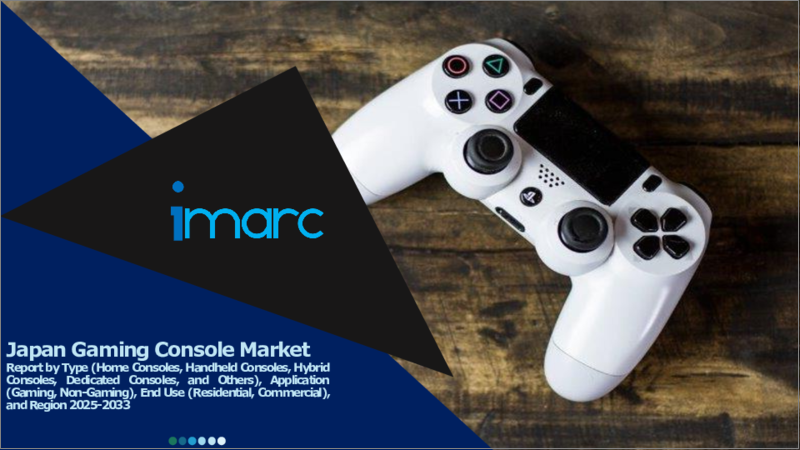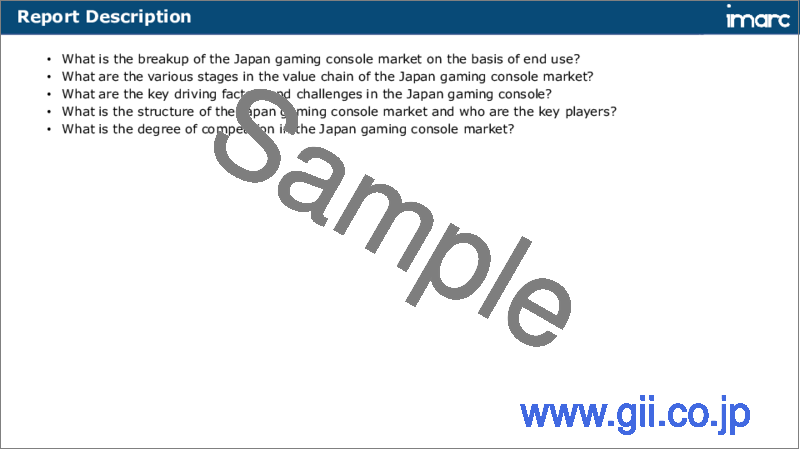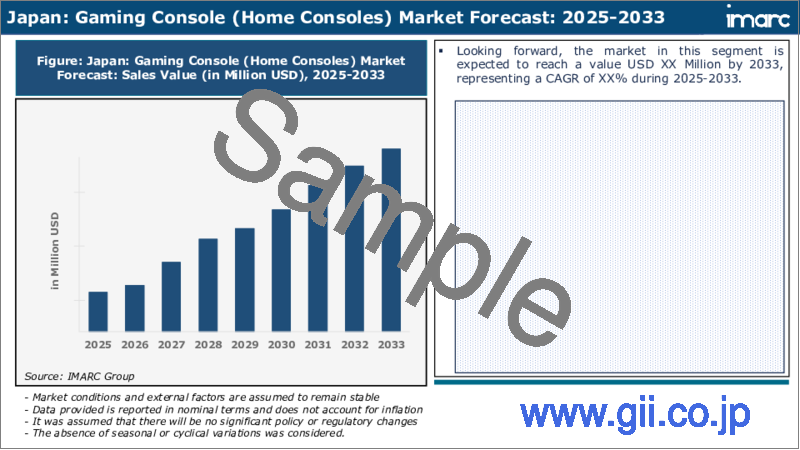|
|
市場調査レポート
商品コード
1729531
日本のゲーム機市場レポート:タイプ、用途、最終用途、地域別、2025年~2033年Japan Gaming Console Market Report by Type (Home Consoles, Handheld Consoles, Hybrid Consoles, Dedicated Consoles, and Others), Application (Gaming, Non-Gaming), End Use (Residential, Commercial), and Region 2025-2033 |
||||||
カスタマイズ可能
|
|||||||
| 日本のゲーム機市場レポート:タイプ、用途、最終用途、地域別、2025年~2033年 |
|
出版日: 2025年05月01日
発行: IMARC
ページ情報: 英文 119 Pages
納期: 5~7営業日
|
全表示
- 概要
- 目次
日本のゲーム機の市場規模は2024年に30億米ドルに達しました。今後、IMARC Groupは、2033年には70億米ドルに達し、2025年から2033年にかけて9.1%の成長率(CAGR)を示すと予測しています。市場は、eスポーツの普及拡大、主要なステークホルダーの支援を受ける著名なeスポーツ大会の登場、ソーシャルメディアプラットフォームの台頭、そしてゲームコミュニティにおける影響力のある人物の台頭など、いくつかの重要な要因によって成長を牽引しています。
本レポートで扱う主な質問
- 日本のゲーム機市場のこれまでの推移と今後の推移は?
- COVID-19が日本のゲーム機市場に与えた影響は?
- 日本のゲーム機市場のタイプ別区分は?
- 日本のゲーム機市場の用途別区分は?
- 日本のゲーム機市場のエンドユーザー別区分は?
- 日本のゲーム機市場のバリューチェーンにおける様々なステージとは?
- 日本のゲーム機の主な促進要因と課題は何か?
- 日本のゲーム機市場の構造と主要プレーヤーは?
- 日本のゲーム機市場における競合の程度は?
目次
第1章 序文
第2章 調査範囲と調査手法
- 調査の目的
- ステークホルダー
- データソース
- 市場推定
- 調査手法
第3章 エグゼクティブサマリー
第4章 日本のゲーム機市場:イントロダクション
- 概要
- 市場力学
- 業界動向
- 競合情報
第5章 日本のゲーム機市場情勢
- 過去および現在の市場動向(2019~2024年)
- 市場予測(2025~2033年)
第6章 日本のゲーム機市場:タイプ別内訳
- 家庭用ゲーム機
- ハンドヘルドゲーム機
- ハイブリッドコンソール
- 専用コンソール
- その他
第7章 日本のゲーム機市場:用途別内訳
- ゲーム
- ゲーム以外
第8章 日本のゲーム機市場:最終用途別内訳
- 住宅
- 商業
第9章 日本のゲーム機市場:競合情勢
- 概要
- 市場構造
- 市場企業のポジショニング
- 主要成功戦略
- 競合ダッシュボード
- 企業評価象限
第10章 主要企業のプロファイル
第11章 日本のゲーム機市場:業界分析
- 促進要因、抑制要因、機会
- ポーターのファイブフォース分析
- バリューチェーン分析
第12章 付録
Japan gaming console market size reached USD 3.0 Billion in 2024. Looking forward, IMARC Group expects the market to reach USD 7.0 Billion by 2033, exhibiting a growth rate (CAGR) of 9.1% during 2025-2033. The market is witnessing growth driven by several significant factors, including the increasing widespread appeal of esports, the introduction of prominent esports competitions often supported by major stakeholders, and the emergence of social media platforms and influential figures within the gaming community.
A gaming console is a specialized computing device primarily intended for engaging in video games. In contrast to a personal computer, which serves a multitude of purposes, a gaming console is purpose-built to excel in rendering graphics, executing game mechanics, and delivering a seamless interactive gaming experience. Typically, this device comprises a central unit that connects to a display screen, such as a television, and one or more controllers for user input. Over time, gaming consoles have undergone evolution to encompass various features like internet connectivity, digital content downloads, and integration with social media, thus transforming into versatile entertainment centers. Moreover, they establish their unique ecosystem comprising exclusive games, online services, and accompanying accessories. The user-friendly interface, plug-and-play convenience, and curated selection of games render gaming consoles a favored choice for both casual and dedicated gamers alike.
Japan Gaming Console Market Trends:
The Japan gaming console market is significantly influenced by the surging popularity of Esports, which involves competitive video gaming among a broad audience. Gaming consoles play a pivotal role in facilitating this trend, providing a standardized platform that ensures fair competition among players. The market is further energized by the hosting of high-profile esports tournaments, often backed by major industry players or third-party organizations, resulting in substantial media exposure and substantial prize pools. The desire to compete at a professional level has driven consumer demand for high-performance gaming consoles, characterized by top-tier processing speeds, minimal latency, and exceptional graphical capabilities. Additionally, the swift sell-out of limited edition consoles and exclusive game releases indicates consumers' willingness to invest in premium gaming experiences. This increased consumer spending has provided the industry with additional resources for research and development, production, and marketing, further propelling market expansion. Moreover, the market benefits from the growing presence of social media platforms and gaming influencers who actively promote video games. Additionally, the increasing integration between gaming consoles and other smart devices is expected to create a positive outlook for the market in the coming years.
Japan Gaming Console Market Segmentation:
Type Insights:
- Home Consoles
- Handheld Consoles
- Hybrid Consoles
- Dedicated Consoles
- Others
Application Insights:
- Gaming
- Non-Gaming
End Use Insights:
- Residential
- Commercial
Competitive Landscape:
The market research report has also provided a comprehensive analysis of the competitive landscape in the market. Competitive analysis such as market structure, key player positioning, top winning strategies, competitive dashboard, and company evaluation quadrant has been covered in the report. Also, detailed profiles of all major companies have been provided.
Key Questions Answered in This Report:
- How has the Japan gaming console market performed so far and how will it perform in the coming years?
- What has been the impact of COVID-19 on the Japan gaming console market?
- What is the breakup of the Japan gaming console market on the basis of type?
- What is the breakup of the Japan gaming console market on the basis of application?
- What is the breakup of the Japan gaming console market on the basis of end use?
- What are the various stages in the value chain of the Japan gaming console market?
- What are the key driving factors and challenges in the Japan gaming console?
- What is the structure of the Japan gaming console market and who are the key players?
- What is the degree of competition in the Japan gaming console market?
Table of Contents
1 Preface
2 Scope and Methodology
- 2.1 Objectives of the Study
- 2.2 Stakeholders
- 2.3 Data Sources
- 2.3.1 Primary Sources
- 2.3.2 Secondary Sources
- 2.4 Market Estimation
- 2.4.1 Bottom-Up Approach
- 2.4.2 Top-Down Approach
- 2.5 Forecasting Methodology
3 Executive Summary
4 Japan Gaming Console Market - Introduction
- 4.1 Overview
- 4.2 Market Dynamics
- 4.3 Industry Trends
- 4.4 Competitive Intelligence
5 Japan Gaming Console Market Landscape
- 5.1 Historical and Current Market Trends (2019-2024)
- 5.2 Market Forecast (2025-2033)
6 Japan Gaming Console Market - Breakup by Type
- 6.1 Home Consoles
- 6.1.1 Overview
- 6.1.2 Historical and Current Market Trends (2019-2024)
- 6.1.3 Market Forecast (2025-2033)
- 6.2 Handheld Consoles
- 6.2.1 Overview
- 6.2.2 Historical and Current Market Trends (2019-2024)
- 6.2.3 Market Forecast (2025-2033)
- 6.3 Hybrid Consoles
- 6.3.1 Overview
- 6.3.2 Historical and Current Market Trends (2019-2024)
- 6.3.3 Market Forecast (2025-2033)
- 6.4 Dedicated Consoles
- 6.4.1 Overview
- 6.4.2 Historical and Current Market Trends (2019-2024)
- 6.4.3 Market Forecast (2025-2033)
- 6.5 Others
- 6.5.1 Historical and Current Market Trends (2019-2024)
- 6.5.2 Market Forecast (2025-2033)
7 Japan Gaming Console Market - Breakup by Application
- 7.1 Gaming
- 7.1.1 Overview
- 7.1.2 Historical and Current Market Trends (2019-2024)
- 7.1.3 Market Forecast (2025-2033)
- 7.2 non-gaming
- 7.2.1 Overview
- 7.2.2 Historical and Current Market Trends (2019-2024)
- 7.2.3 Market Forecast (2025-2033)
8 Japan Gaming Console Market - Breakup by End Use
- 8.1 Residential
- 8.1.1 Overview
- 8.1.2 Historical and Current Market Trends (2019-2024)
- 8.1.3 Market Forecast (2025-2033)
- 8.2 Commercial
- 8.2.1 Overview
- 8.2.2 Historical and Current Market Trends (2019-2024)
- 8.2.3 Market Forecast (2025-2033)
9 Japan Gaming Console Market - Competitive Landscape
- 9.1 Overview
- 9.2 Market Structure
- 9.3 Market Player Positioning
- 9.4 Top Winning Strategies
- 9.5 Competitive Dashboard
- 9.6 Company Evaluation Quadrant
10 Profiles of Key Players
- 10.1 Company A
- 10.1.1 Business Overview
- 10.1.2 Product Portfolio
- 10.1.3 Business Strategies
- 10.1.4 SWOT Analysis
- 10.1.5 Major News and Events
- 10.2 Company B
- 10.2.1 Business Overview
- 10.2.2 Product Portfolio
- 10.2.3 Business Strategies
- 10.2.4 SWOT Analysis
- 10.2.5 Major News and Events
- 10.3 Company C
- 10.3.1 Business Overview
- 10.3.2 Product Portfolio
- 10.3.3 Business Strategies
- 10.3.4 SWOT Analysis
- 10.3.5 Major News and Events
- 10.4 Company D
- 10.4.1 Business Overview
- 10.4.2 Product Portfolio
- 10.4.3 Business Strategies
- 10.4.4 SWOT Analysis
- 10.4.5 Major News and Events
- 10.5 Company E
- 10.5.1 Business Overview
- 10.5.2 Product Portfolio
- 10.5.3 Business Strategies
- 10.5.4 SWOT Analysis
- 10.5.5 Major News and Events
11 Japan Gaming Console Market - Industry Analysis
- 11.1 Drivers, Restraints and Opportunities
- 11.1.1 Overview
- 11.1.2 Drivers
- 11.1.3 Restraints
- 11.1.4 Opportunities
- 11.2 Porters Five Forces Analysis
- 11.2.1 Overview
- 11.2.2 Bargaining Power of Buyers
- 11.2.3 Bargaining Power of Suppliers
- 11.2.4 Degree of Competition
- 11.2.5 Threat of New Entrants
- 11.2.6 Threat of Substitutes
- 11.3 Value Chain Analysis






